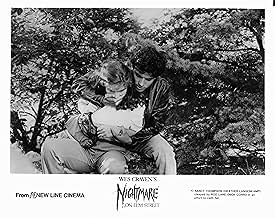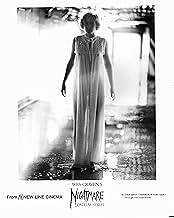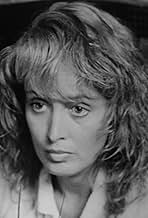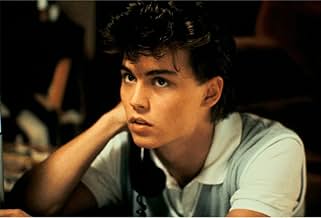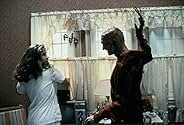Lo spirito mostruoso di un bidello ucciso cerca vendetta invadendo i sogni di adolescenti i cui genitori erano responsabili della sua morte prematura.Lo spirito mostruoso di un bidello ucciso cerca vendetta invadendo i sogni di adolescenti i cui genitori erano responsabili della sua morte prematura.Lo spirito mostruoso di un bidello ucciso cerca vendetta invadendo i sogni di adolescenti i cui genitori erano responsabili della sua morte prematura.
- Regia
- Sceneggiatura
- Star
- Premi
- 7 vittorie e 8 candidature totali
Jsu Garcia
- Rod Lane
- (as Nick Corri)
Mimi Craven
- Nurse
- (as Mimi Meyer-Craven)
Jeff Levine
- Coroner
- (as Jeffrey Levine)
Recensioni in evidenza
On Elm Street, the teenager Tina Gray (Amanda Wyss) has a creepy nightmare with a burned man wearing a glove with blades called Freddy Krueger (Robert Englund). She invites her friends Nancy Thompson (Heather Langenkamp), who had also a nightmare with Freddy Krueger, and Glen Lantz (Johnny Depp) to spend the next night with her, but her boy-friend Rod Lane (Nick Corri) appears in the house and they spend the night together. In the middle of the night, Rod awakes and sees Tina having a nightmare and being sliced. He is accused of murder and arrested by Nancy's father Lt. Thompson (John Saxon), despite the protests of his daughter. When Rod and Glen are mysteriously murdered, Nancy realizes that the only way to defeat the evil Freddy Krueger is bringing him to the real world.
The classic "A Nightmare on Elm Street" is one of the best horror movies of the 80's and Freddy Krueger is my favorite villain. The story is original, very well written and directed by Wes Craven and is the debut of Johnny Depp in the cinema. As far as I know, the open conclusion was forced by the producers to give a sequel to the saga of Freddy Krueger. My vote is eight.
Title (Brazil): "A Hora do Pesadelo" ("The Hour of the Nightmare")
The classic "A Nightmare on Elm Street" is one of the best horror movies of the 80's and Freddy Krueger is my favorite villain. The story is original, very well written and directed by Wes Craven and is the debut of Johnny Depp in the cinema. As far as I know, the open conclusion was forced by the producers to give a sequel to the saga of Freddy Krueger. My vote is eight.
Title (Brazil): "A Hora do Pesadelo" ("The Hour of the Nightmare")
Nancy is having grisly nightmares. Meanwhile, her high-school friends, who are having the very same dreams, are being slaughtered in their sleep by the hideous fiend of their shared nightmares. When the police ignore her explanation, she herself must confront the killer in her shadowy realm.
This Film Starred: John Saxon, Heather Langenkamp & Johnny Depp.
A Nightmare on Elm Street was released in 1984 was written and directed by Wes Craven.
In my personal opinion this was a great film, it had it's scary moments which every horror should have unfortunately they did go a bit far on a couple of the sequels which got rather low ratings on here. Not all of the sequels are bad, for example I am a fan of 3 & 4 but sequels like 2 & 5 ARE GIVING THE Freddy movies a bad name and are shadowing the excellence of this movie in particular. People seem to recognise Freddy Krueger as the burnt serial killer with knives for fingers who appeared in all them bad films. A Nightmare on Elm Street 1984 is not one of them films and should be recognised as a the great movie it is. I highly recommend this film to all fans of the horror genre.
****/***** Very Good.
This Film Starred: John Saxon, Heather Langenkamp & Johnny Depp.
A Nightmare on Elm Street was released in 1984 was written and directed by Wes Craven.
In my personal opinion this was a great film, it had it's scary moments which every horror should have unfortunately they did go a bit far on a couple of the sequels which got rather low ratings on here. Not all of the sequels are bad, for example I am a fan of 3 & 4 but sequels like 2 & 5 ARE GIVING THE Freddy movies a bad name and are shadowing the excellence of this movie in particular. People seem to recognise Freddy Krueger as the burnt serial killer with knives for fingers who appeared in all them bad films. A Nightmare on Elm Street 1984 is not one of them films and should be recognised as a the great movie it is. I highly recommend this film to all fans of the horror genre.
****/***** Very Good.
A legendary horror with one of the most popular slasher killers of the 80s-90s. The beginning of this franchise turned out to be more than successful, an original idea with a mysterious maniac and an atmosphere, it is in this part that the intrigue of horror is most sustained.
The young cast is quite good, it was here that Johnny Depp started, Freddie has not yet become that charismatic killer with his jokes, as in subsequent parts. So far, he is more secretive and tries to instill fear in all the victims.
Many people at that time were afraid to sleep after watching, nowadays it's hard to scare you with this movie, but you'll still get pleasure!
The young cast is quite good, it was here that Johnny Depp started, Freddie has not yet become that charismatic killer with his jokes, as in subsequent parts. So far, he is more secretive and tries to instill fear in all the victims.
Many people at that time were afraid to sleep after watching, nowadays it's hard to scare you with this movie, but you'll still get pleasure!
Every small-town neighborhood has an old legend that never dies. For the residents of Elm Street, Fred Krueger is the demonic soul that plagues their nightmares. Krueger was an evil child molester, burned alive by the parents of the children he had slain in the past. Now, years later, he has reappeared in the nightmares of Elm Street's teenagers. Nancy (Heather Langenkamp) continually experiences these haunting visions in which the permanently scarred man chases her through the shadows of a boiler room -- the same room in which he used to slay his helpless victims. Nancy considers her dreams to be typical nightmares one of her best friends is apparently "sliced" to death during a deep sleep in her home.
Soon Nancy's dreams become worse, and her boyfriend Glen (Johnny Depp) admits that he has also been experiencing unpleasant nightmares. Together they uncover the truth behind Krueger's death years ago, and vow to stay awake as long as they can and strategize a plan to bring Krueger back into the "real world" and kill him once and for all.
Loosely based on true events, Wes Craven's inspiration for the tale originated after he reportedly read that a number of people across the world had died in their slumber. Blending fantasy with reality, Craven wrote and directed one of the most iconic horror films of all time, which -- similar to "Halloween" before it -- spawned an inferior legion of sequels and imitators, all of which continue to pale in comparison to the original.
The brilliance of "A Nightmare on Elm Street" is that it relies on psychological fear vs. cheap exploitation tricks. "Halloween," directed by John Carpenter and released in 1978, had re-sparked interest in the Hitchcock-style horror/thrillers, and "A Nightmare on Elm Street" builds upon this, cleverly channeling the mystery surrounding dreams and using it as a gateway for chills and thrills. Midway through the movie, a doctor played by Richard Fleischer tells Nancy's mother that the process of dreams -- where do they come from? -- has yet to be explained, and the fact that all humans tend to have dreams on a regular basis is essentially why this film remains so scary, even by today's standards. Some of the special effects are quite outdated but, unlike the "Nightmare" imitators, gore plays second to the plot and characters -- something rare in a horror film.
The sequels became sillier and gorier. Fred's name changed to the less menacing "Freddy" (which we all now know him by), he was given more screen time, the makeup on his face was not quite as horrific, he began to crack jokes more often and his voice evolved into a less demonic cackle. In the original "Nightmare" it is interesting to note that Freddy is rarely given screen time at all -- we see his infamous hands (wearing gloves with butter knives attached on the fingers to slice his victims), we see his hat, we see his sweater, we see his outline in the darkness of the shadows, but even when we finally see Freddy up-close, Craven manages to keep the camera moving so that we never gain a distinct image of the killer. Now, twenty years later, there's no mystery anymore -- Freddy's face is featured on the front cover for most of the films and his very presence has become the cornerstone of all the movies in the franchise. But in 1984, long before Craven predicted his character would become a huge part of modern pop culture, Freddy was mysterious and not very funny at all.
The acting is one of the film's weaknesses -- Heather Langenkamp is never totally awe-inspiring as Nancy, truth be told (although she does a decent job); Depp -- in his big-screen debut -- shows a sign of talent to come but basically mutters clichéd dialogue most of the time. The co-stars are acceptable at best. However the greatest performance is -- not surprisingly -- by Robert Englund, as Freddy, who is in the film barely at all. Ironically, as mentioned above, this only makes the film succeed at scaring us.
The direction is not as superb as "Halloween," and for that matter either is the film. Over the years, "Nightmare" has arguably been given an overrated reputation, although it is inferior to "Halloween." However, compared to some of the other so-called "horror films" released during the '80s -- including "Friday the 13th" and other dumb slasher flicks -- "A Nightmare on Elm Street" does seem to stand as one of the best horror films of the decade. Despite its flaws it is quite smart with a surprise "final" ending and one of cinema's greatest villains lurking at the core.
"A Nightmare on Elm Street" is really Nancy's story. The film focuses on Nancy's troubles, Nancy's dreams and Nancy's actions. The ending of the film becomes a bit muddled -- the booby traps are unfortunately a bit goofy and Freddy helplessly (almost humorously) chasing Nancy around her home supposedly trying to murder her is something the film could have done without -- but overall it is a satisfying mixture of horror, thriller and fantasy, a movie that taps into two seldom-recognized everyday events in human life, which are sleeping, and dreaming. Craven's ability to realize this unknown fear in a movie is, needless to say, quite fascinating. "A Nightmare on Elm Street" is not a great movie but for horror buffs it is a must-see and for non-horror-buffs there is a fair amount of other elements to sustain one's interest.
Soon Nancy's dreams become worse, and her boyfriend Glen (Johnny Depp) admits that he has also been experiencing unpleasant nightmares. Together they uncover the truth behind Krueger's death years ago, and vow to stay awake as long as they can and strategize a plan to bring Krueger back into the "real world" and kill him once and for all.
Loosely based on true events, Wes Craven's inspiration for the tale originated after he reportedly read that a number of people across the world had died in their slumber. Blending fantasy with reality, Craven wrote and directed one of the most iconic horror films of all time, which -- similar to "Halloween" before it -- spawned an inferior legion of sequels and imitators, all of which continue to pale in comparison to the original.
The brilliance of "A Nightmare on Elm Street" is that it relies on psychological fear vs. cheap exploitation tricks. "Halloween," directed by John Carpenter and released in 1978, had re-sparked interest in the Hitchcock-style horror/thrillers, and "A Nightmare on Elm Street" builds upon this, cleverly channeling the mystery surrounding dreams and using it as a gateway for chills and thrills. Midway through the movie, a doctor played by Richard Fleischer tells Nancy's mother that the process of dreams -- where do they come from? -- has yet to be explained, and the fact that all humans tend to have dreams on a regular basis is essentially why this film remains so scary, even by today's standards. Some of the special effects are quite outdated but, unlike the "Nightmare" imitators, gore plays second to the plot and characters -- something rare in a horror film.
The sequels became sillier and gorier. Fred's name changed to the less menacing "Freddy" (which we all now know him by), he was given more screen time, the makeup on his face was not quite as horrific, he began to crack jokes more often and his voice evolved into a less demonic cackle. In the original "Nightmare" it is interesting to note that Freddy is rarely given screen time at all -- we see his infamous hands (wearing gloves with butter knives attached on the fingers to slice his victims), we see his hat, we see his sweater, we see his outline in the darkness of the shadows, but even when we finally see Freddy up-close, Craven manages to keep the camera moving so that we never gain a distinct image of the killer. Now, twenty years later, there's no mystery anymore -- Freddy's face is featured on the front cover for most of the films and his very presence has become the cornerstone of all the movies in the franchise. But in 1984, long before Craven predicted his character would become a huge part of modern pop culture, Freddy was mysterious and not very funny at all.
The acting is one of the film's weaknesses -- Heather Langenkamp is never totally awe-inspiring as Nancy, truth be told (although she does a decent job); Depp -- in his big-screen debut -- shows a sign of talent to come but basically mutters clichéd dialogue most of the time. The co-stars are acceptable at best. However the greatest performance is -- not surprisingly -- by Robert Englund, as Freddy, who is in the film barely at all. Ironically, as mentioned above, this only makes the film succeed at scaring us.
The direction is not as superb as "Halloween," and for that matter either is the film. Over the years, "Nightmare" has arguably been given an overrated reputation, although it is inferior to "Halloween." However, compared to some of the other so-called "horror films" released during the '80s -- including "Friday the 13th" and other dumb slasher flicks -- "A Nightmare on Elm Street" does seem to stand as one of the best horror films of the decade. Despite its flaws it is quite smart with a surprise "final" ending and one of cinema's greatest villains lurking at the core.
"A Nightmare on Elm Street" is really Nancy's story. The film focuses on Nancy's troubles, Nancy's dreams and Nancy's actions. The ending of the film becomes a bit muddled -- the booby traps are unfortunately a bit goofy and Freddy helplessly (almost humorously) chasing Nancy around her home supposedly trying to murder her is something the film could have done without -- but overall it is a satisfying mixture of horror, thriller and fantasy, a movie that taps into two seldom-recognized everyday events in human life, which are sleeping, and dreaming. Craven's ability to realize this unknown fear in a movie is, needless to say, quite fascinating. "A Nightmare on Elm Street" is not a great movie but for horror buffs it is a must-see and for non-horror-buffs there is a fair amount of other elements to sustain one's interest.
While I love horror films, I am not a big fan of the slasher genre, which has come to dominate and indeed practically to define horror since the late 1970s. While I do love the original "Psycho," most slasher films follow a different, and far more predictable, formula. The idea of a faceless killer going around stabbing teenagers just doesn't frighten me a whole lot, though some of these films do fill me with disgust--a rather different sort of emotion.
I am far more frightened by films that deal with distortions of reality, where it's hard for the characters to tell what's real and what's not. Admittedly, that genre isn't always so lofty either. Dreams are one of the most overused devices in the movies, having a whole set of clichés associated with them. We are all familiar with the common scene in which a character awakens from a nightmare by jerking awake in cold sweat. This convention is not only overused, it's blatantly unrealistic, for people waking up from dreams do not jerk awake in such a violent fashion. Moreover, these scenes are usually nothing more than little throwaway sequences designed to amuse or frighten the audience without advancing the plot.
What makes "Nightmare on Elm Street" so clever is how it creates an entirely new convention for representing dreams on screen. The dreaming scenes are filmed with an airy, murky quality, but so are many of the waking scenes, making it very difficult to tell whether a character is awake or asleep. Indeed, the movie never shows any character actually fall asleep, and as a result we are constantly on guard whenever characters so much as close their eyes for a moment. In crucial scenes, it is impossible to tell whether what we are seeing is real or happening only in a character's mind. But the movie ultimately suggests that the difference doesn't matter. The premise of the movie, in which a child-killer haunts teenager's dreams and has the capability of killing them while they're asleep, turns the whole "It was all just a dream" convention on its head: in this movie, the real world is safe, and the dream world is monstrously dangerous.
The movie finds a number of ways to explore this ambiguity, including a bathtub scene that invites comparisons with the shower scene in "Psycho" without being a cheap ripoff. My personal favorite scene, and one of the scariest I've ever seen in a movie, is the one where Nancy dozes off in the classroom while a student is standing up in front of the class reading a passage from Shakespeare. The way the scene transitions from the real classroom to a nightmarish version of it is brilliantly subtle.
The director, Wes Craven, understood that the anticipation of danger is usually more frightening than the final attack. There are some great visual shots to that effect, including one where Freddy's arms becomes unnaturally long in an alleyway, and another where the stairs literally turn into a gooey substance, in imitation of the common nightmare where it is hard to get away from a pursuer. The movie continually finds creative ways to tease the audience, never resorting to red herring, that tired old convention used in almost all other slasher films.
Despite the creativity in these scenes, "A Nightmare on Elm Street" is still a formula movie, with relatively one-dimensional characters and no great performances. This was Johnny Depp's first role, as Heather Langenkamp's boyfriend, and although he does get a few neat lines of exposition (his speech about "dream skills"), his personality is not fleshed out, and there is no sense of the great actor Depp would go on to become.
Within the genre, however, "A Nightmare on Elm Street" is a fine work. My main criticism isn't its failure to transcend the formula, but its confusing and obtuse ending, apparently put there in anticipation of sequels, but managing to create a mystery that the sequels were unable to clear up. The climactic confrontation between Freddy and Nancy is weakly handled. The crucial words she says to him are surprisingly clunky, and her father's muted behavior during that scene is almost inexplicable. It has led me to consider an alternative interpretation of the scene, but one that feels like a cop-out. The scene that follows, and where the movie ends, is anticlimactic and unnecessary. These clumsily-made final two scenes come close to ruining the movie, and it is a testament to the film's many good qualities that it still stands as an unusually effective horror film that invites repeat viewings.
I am far more frightened by films that deal with distortions of reality, where it's hard for the characters to tell what's real and what's not. Admittedly, that genre isn't always so lofty either. Dreams are one of the most overused devices in the movies, having a whole set of clichés associated with them. We are all familiar with the common scene in which a character awakens from a nightmare by jerking awake in cold sweat. This convention is not only overused, it's blatantly unrealistic, for people waking up from dreams do not jerk awake in such a violent fashion. Moreover, these scenes are usually nothing more than little throwaway sequences designed to amuse or frighten the audience without advancing the plot.
What makes "Nightmare on Elm Street" so clever is how it creates an entirely new convention for representing dreams on screen. The dreaming scenes are filmed with an airy, murky quality, but so are many of the waking scenes, making it very difficult to tell whether a character is awake or asleep. Indeed, the movie never shows any character actually fall asleep, and as a result we are constantly on guard whenever characters so much as close their eyes for a moment. In crucial scenes, it is impossible to tell whether what we are seeing is real or happening only in a character's mind. But the movie ultimately suggests that the difference doesn't matter. The premise of the movie, in which a child-killer haunts teenager's dreams and has the capability of killing them while they're asleep, turns the whole "It was all just a dream" convention on its head: in this movie, the real world is safe, and the dream world is monstrously dangerous.
The movie finds a number of ways to explore this ambiguity, including a bathtub scene that invites comparisons with the shower scene in "Psycho" without being a cheap ripoff. My personal favorite scene, and one of the scariest I've ever seen in a movie, is the one where Nancy dozes off in the classroom while a student is standing up in front of the class reading a passage from Shakespeare. The way the scene transitions from the real classroom to a nightmarish version of it is brilliantly subtle.
The director, Wes Craven, understood that the anticipation of danger is usually more frightening than the final attack. There are some great visual shots to that effect, including one where Freddy's arms becomes unnaturally long in an alleyway, and another where the stairs literally turn into a gooey substance, in imitation of the common nightmare where it is hard to get away from a pursuer. The movie continually finds creative ways to tease the audience, never resorting to red herring, that tired old convention used in almost all other slasher films.
Despite the creativity in these scenes, "A Nightmare on Elm Street" is still a formula movie, with relatively one-dimensional characters and no great performances. This was Johnny Depp's first role, as Heather Langenkamp's boyfriend, and although he does get a few neat lines of exposition (his speech about "dream skills"), his personality is not fleshed out, and there is no sense of the great actor Depp would go on to become.
Within the genre, however, "A Nightmare on Elm Street" is a fine work. My main criticism isn't its failure to transcend the formula, but its confusing and obtuse ending, apparently put there in anticipation of sequels, but managing to create a mystery that the sequels were unable to clear up. The climactic confrontation between Freddy and Nancy is weakly handled. The crucial words she says to him are surprisingly clunky, and her father's muted behavior during that scene is almost inexplicable. It has led me to consider an alternative interpretation of the scene, but one that feels like a cop-out. The scene that follows, and where the movie ends, is anticlimactic and unnecessary. These clumsily-made final two scenes come close to ruining the movie, and it is a testament to the film's many good qualities that it still stands as an unusually effective horror film that invites repeat viewings.
Lo sapevi?
- QuizNew Line Cinema was saved from bankruptcy by the success of the film, and was jokingly nicknamed "The House that Freddy Built."
- BlooperAt the 1hr 11 min mark, Nancy tells her father "to break the door down in exactly 20 minutes" at 12:30 am, making the current time 12:10 am. In this time, she manages to set various booby traps--a bomb from a light bulb and gunpowder, a raised sledgehammer, a tripwire, and screwing a bolt to a door, and then sits with her mother for some time before going to her own bedroom. All of this was apparently done in only 10 minutes! She's shown in bed at 12:20 am, giving herself 10 minutes to fall asleep and catch Freddy.
- Citazioni
Children: One, two, Freddy's coming for you. / Three, four, better lock your door. / Five, six, grab your crucifix. / Seven, eight, gonna stay up late. / Nine, ten, never sleep again.
- Curiosità sui creditiFilm title logo as the end credits are finished.
- Versioni alternativeThe German television version is heavily cut, allowing for an earlier time slot. The cuts are:
- When Tina is sliced by Freddy Krueger, we don't see how he slices her chest and is pulled to the ceiling.
- In Tina's last dream we don't see when Freddy cuts his own fingers off his hand. Later, there is a scene where Freddy's face is pulled off by Tina. This scene is also missing.
- When Nancy meets Freddy for the first time, we can't see when he slices his abdomen and when Nancy puts her arm on the hot pipe.
- When Rod's neck is broken by Freddy Krueger, we only see Rod looking at the "snake", before it kills him.
- The scene where the dead Tina is talking to Nancy while snakes are coming out her dress is also cut.
- Glen's famous dead scene is also cut. We only see how he is sucked in his bed. The bloody, second half is cut.
- When Nancy is burning Freddy, we only see the fire reach his feet, then it cuts to Nancy calling her dad.
- The scene where Freddy is killing Nancy's mother by burning her is also cut.
- These changes were also made in the German video version, which has a "not under 16 years" rating. The uncut version is sometimes shown on Pay-Per-View and is rated "not under 18 years."
- Colonne sonoreNightmare
Performed by 213
Written and Produced by Martin Kent, Steve Karshner, Michael Schurig
I più visti
Accedi per valutare e creare un elenco di titoli salvati per ottenere consigli personalizzati
- How long is A Nightmare on Elm Street?Powered by Alexa
Dettagli
- Data di uscita
- Paese di origine
- Lingua
- Celebre anche come
- Pesadilla en la calle del infierno
- Luoghi delle riprese
- Aziende produttrici
- Vedi altri crediti dell’azienda su IMDbPro
Botteghino
- Budget
- 1.800.000 USD (previsto)
- Lordo Stati Uniti e Canada
- 25.624.448 USD
- Fine settimana di apertura Stati Uniti e Canada
- 1.271.000 USD
- 11 nov 1984
- Lordo in tutto il mondo
- 25.858.510 USD
Contribuisci a questa pagina
Suggerisci una modifica o aggiungi i contenuti mancanti







